TPMS HONDA ELEMENT 2010 1.G User Guide
[x] Cancel search | Manufacturer: HONDA, Model Year: 2010, Model line: ELEMENT, Model: HONDA ELEMENT 2010 1.GPages: 342, PDF Size: 5.76 MB
Page 288 of 342

Even though your vehicle is
equipped with TPMS, we
recommend that you visually check
your tires every day. If you think a
tire might be low, check it
immediately with a tire gauge.
Use a gauge to measure the air
pressure in each tire at least once a
month. Even tires that are in good
condition may lose 1 to 2 psi (10 to
20 kPa, 0.1 to 0.2 kgf/cm
2) per
month. Remember to check the
spare tire at the same time.
Check the air pressures when the
tires are cold. This means the vehicle
has been parked for at least 3 hours,
or driven less than 1 mile (1.6 km).
Add or release air, if needed, to
match the recommended cold tirepressures. If you check air pressures when the
tires are hot [driven for several miles
(kilometers)], you will see readings 4
to 6 psi (30 to 40 kPa, 0.3 to 0.4 kgf/cm
2) higher than the cold
readings. This is normal. Do not let
air out to match the recommended
cold air pressure. The tire will beunderinflated.
You should get your own tire
pressure gauge and use it whenever
you check your tire pressures. This
will make it easier for you to tell if a
pressure loss is due to a tire problem
and not due to a variation betweengauges.
While tubeless tires have some
ability to self-seal if they are
punctured, you should look closely
for punctures if a tire starts losing pressure. Recommended Tire Pressures
The following chart shows the
recommended cold tire pressures for
most normal and high-speed driving conditions.
On all models except SC
Tire Size Cold Tire Pressure
for Normal Driving
P215/70R16 99S Front:
33 psi (230 kPa,
2.3 kgf/cm
2)
Rear:
35 psi (240 kPa,
2.4 kgf/cm
2)
On SC model
Tire Size Cold Tire Pressure for Normal Driving
P225/55R18 97H Front/Rear:
32 psi (220 kPa,
2.2 kgf/cm
2)
Tires
272
Table of Contents
Page 291 of 342
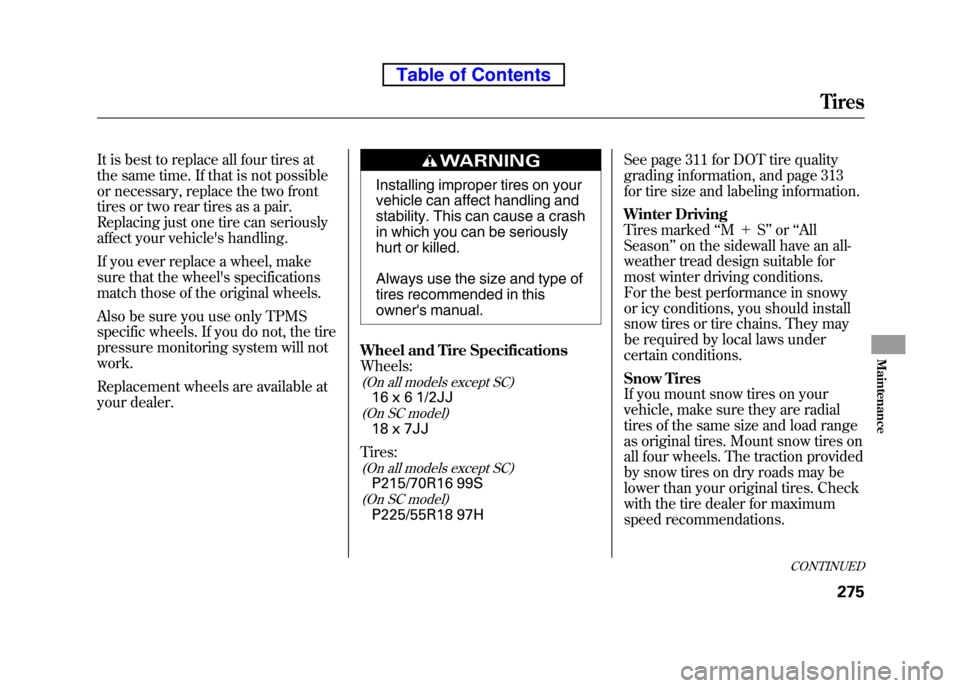
It is best to replace all four tires at
the same time. If that is not possible
or necessary, replace the two front
tires or two rear tires as a pair.
Replacing just one tire can seriously
affect your vehicle's handling.
If you ever replace a wheel, make
sure that the wheel's specifications
match those of the original wheels.
Also be sure you use only TPMS
specific wheels. If you do not, the tire
pressure monitoring system will not work.
Replacement wheels are available at
your dealer.
Installing improper tires on your
vehicle can affect handling and
stability. This can cause a crash
in which you can be seriously
hurt or killed.
Always use the size and type of
tires recommended in this
owner's manual.
Wheel and Tire Specifications Wheels:
(On all models except SC)
16 x 6 1/2JJ
(On SC model)
18 x 7JJ
Tires:
(On all models except SC)
P215/70R16 99S
(On SC model)
P225/55R18 97H See page 311 for DOT tire quality
grading information, and page 313
for tire size and labeling information.
Winter Driving
Tires marked
‘‘M + S’’ or ‘‘All
Season ’’on the sidewall have an all-
weather tread design suitable for
most winter driving conditions.
For the best performance in snowy
or icy conditions, you should install
snow tires or tire chains. They may
be required by local laws under
certain conditions.
Snow Tires
If you mount snow tires on your
vehicle, make sure they are radial
tires of the same size and load range
as original tires. Mount snow tires on
all four wheels. The traction provided
by snow tires on dry roads may be
lower than your original tires. Check
with the tire dealer for maximum
speed recommendations.
CONTINUED
Tires
275
Maintenance
Table of Contents
Page 298 of 342
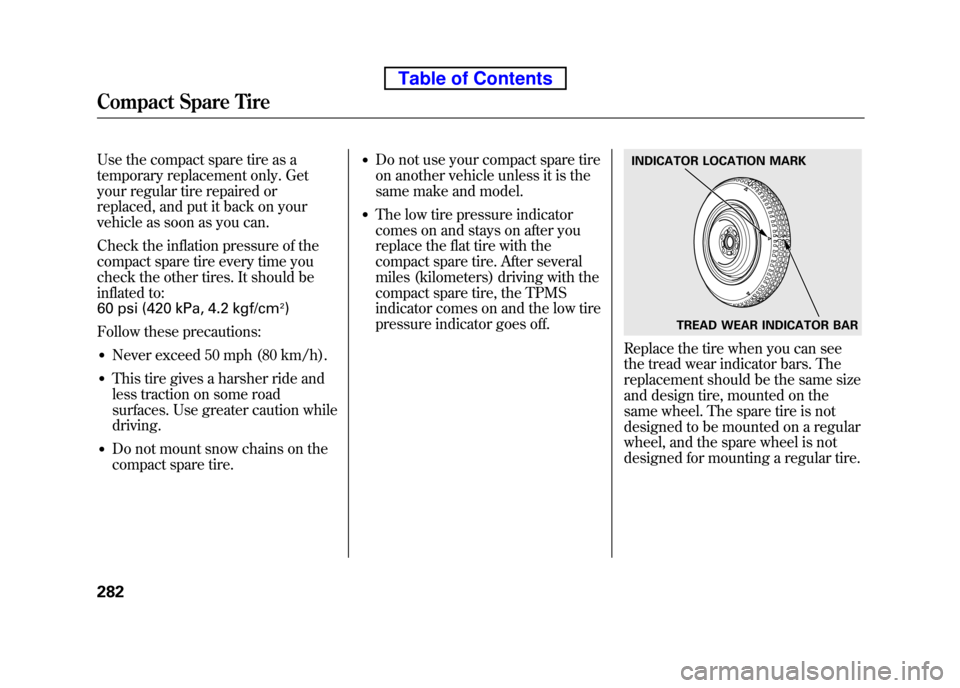
Use the compact spare tire as a
temporary replacement only. Get
your regular tire repaired or
replaced, and put it back on your
vehicle as soon as you can.
Check the inflation pressure of the
compact spare tire every time you
check the other tires. It should be
inflated to:
60 psi (420 kPa, 4.2 kgf/cm
2)
Follow these precautions: ● Never exceed 50 mph (80 km/h).
● This tire gives a harsher ride and
less traction on some road
surfaces. Use greater caution whiledriving.
● Do not mount snow chains on the
compact spare tire. ●
Do not use your compact spare tire
on another vehicle unless it is the
same make and model.
● The low tire pressure indicator
comes on and stays on after you
replace the flat tire with the
compact spare tire. After several
miles (kilometers) driving with the
compact spare tire, the TPMS
indicator comes on and the low tire
pressure indicator goes off.
Replace the tire when you can see
the tread wear indicator bars. The
replacement should be the same size
and design tire, mounted on the
same wheel. The spare tire is not
designed to be mounted on a regular
wheel, and the spare wheel is not
designed for mounting a regular tire.
INDICATOR LOCATION MARK
TREAD WEAR INDICATOR BAR
Compact Spare Tire
282
Table of Contents
Page 304 of 342
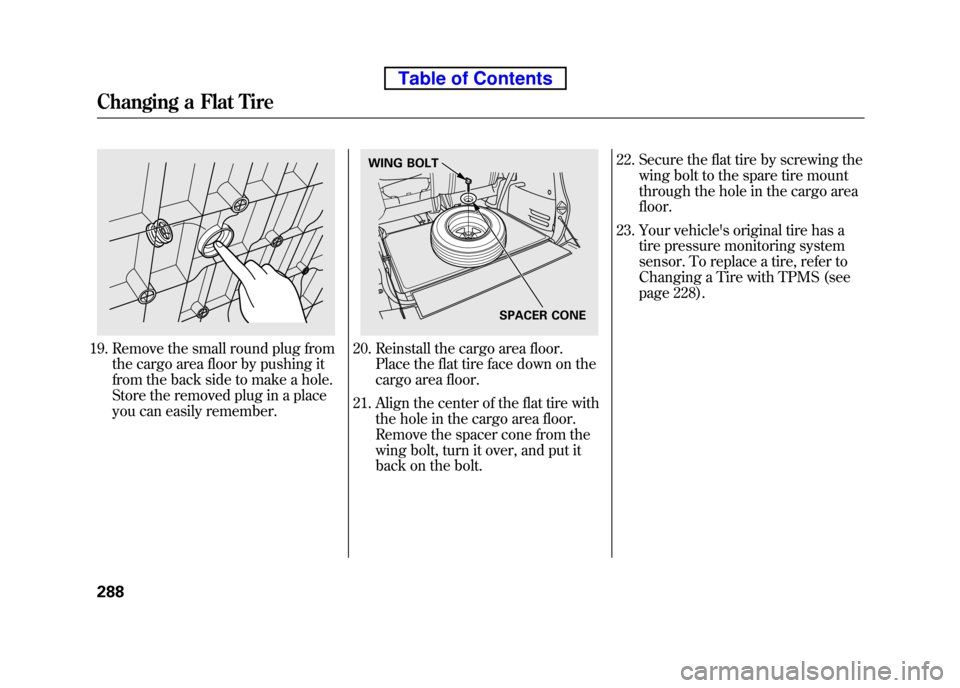
19. Remove the small round plug fromthe cargo area floor by pushing it
from the back side to make a hole.
Store the removed plug in a place
you can easily remember.20. Reinstall the cargo area floor. Place the flat tire face down on the
cargo area floor.
21. Align the center of the flat tire with the hole in the cargo area floor.
Remove the spacer cone from the
wing bolt, turn it over, and put it
back on the bolt. 22. Secure the flat tire by screwing the
wing bolt to the spare tire mount
through the hole in the cargo areafloor.
23. Your vehicle's original tire has a tire pressure monitoring system
sensor. To replace a tire, refer to
Changing a Tire with TPMS (see
page 228).
SPACER CONE
WING BOLT
Changing a Flat Tire
288
Table of Contents
Page 317 of 342
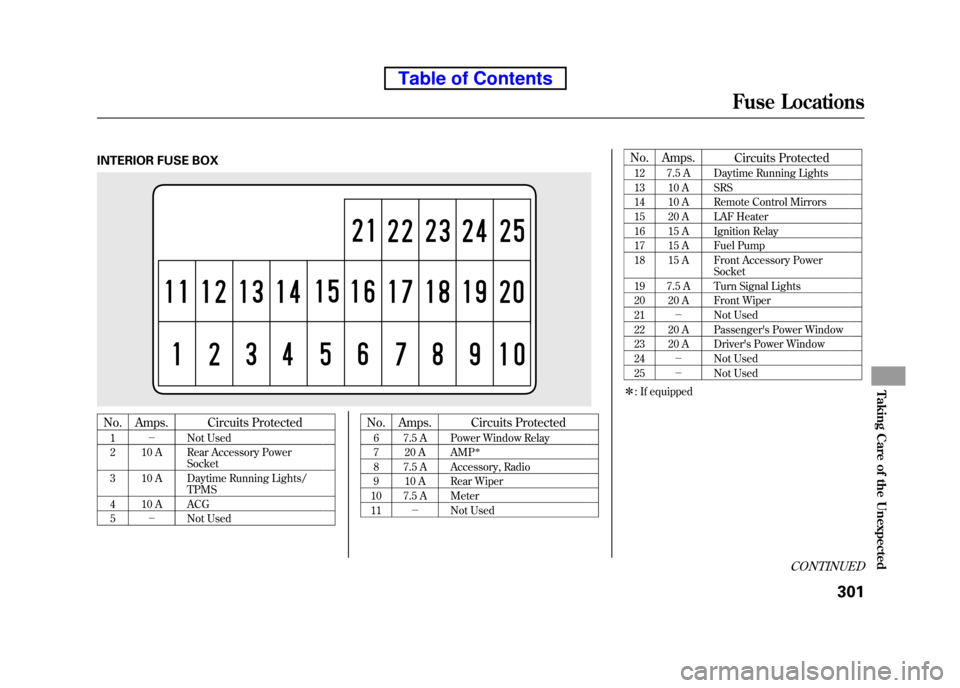
INTERIOR FUSE BOX
No.Amps. Circuits Protected
1 - Not Used
2 10 A Rear Accessory Power Socket
3 10 A Daytime Running Lights/ TPMS
4 10 A ACG 5 - Not Used No. Amps.
Circuits Protected
6 7.5 A Power Window Relay
7 20 A AMP
ꭧ
8 7.5 A Accessory, Radio
9 10 A Rear Wiper
10 7.5 A Meter11 - Not Used No. Amps.
Circuits Protected
12 7.5 A Daytime Running Lights
13 10 A SRS
14 10 A Remote Control Mirrors
15 20 A LAF Heater
16 15 A Ignition Relay
17 15 A Fuel Pump
18 15 A Front Accessory Power Socket
19 7.5 A Turn Signal Lights
20 20 A Front Wiper21 - Not Used
22 20 A Passenger's Power Window
23 20 A Driver's Power Window 24 - Not Used
25 - Not Used
ꭧ : If equipped
CONTINUED
Fuse Locations
301
Taking Care of the Unexpected
Table of Contents
Page 321 of 342
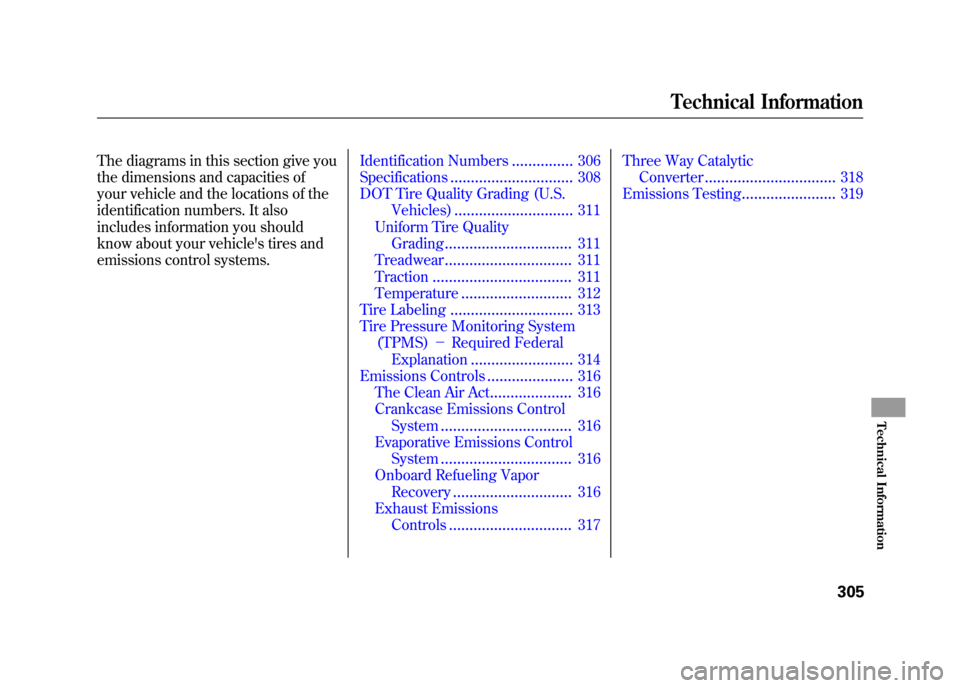
The diagrams in this section give you
the dimensions and capacities of
your vehicle and the locations of the
identification numbers. It also
includes information you should
know about your vehicle's tires and
emissions control systems.Identification Numbers...............306
Specifications ..............................
308
DOT Tire Quality Grading (U.S. Vehicles) ............................. 311
Uniform Tire Quality Grading ............................... 311
Treadwear ............................... 311
Traction .................................. 311
Temperature ...........................
312
Tire Labeling .............................. 313
Tire Pressure Monitoring System
(TPMS) -Required Federal
Explanation ......................... 314
Emissions Controls .....................316
The Clean Air Act ....................
316
Crankcase Emissions Control System ................................ 316
Evaporative Emissions Control
System ................................ 316
Onboard Refueling Vapor
Recovery ............................. 316
Exhaust Emissions
Controls .............................. 317Three Way Catalytic
Converter ................................ 318
Emissions Testing .......................319
Technical Information
305
Technical Information
Page 330 of 342

Glossary of Tire Terminology
Cold Tire Pressure - The tire air
pressure when the vehicle has been
parked for at least three hours or
driven less than 1 mile (1.6km).
Load Rating - Means the maximum
load that a tire is rated to carry for a
given inflation presure.
Maximum Inflation Pressure - the
maximum tire air pressure that the
tire can hold.
Maximum Load Rating - Means the
load rating for a tire at the maximum
permissible inflation pressure for thattire.
Recommended Inflation Pressure -
The cold tire inflation pressure
recommended by the manufacturer.
Treadwear Indicators (TWI) - Means
the projections within the principal
grooves designed to give a visual
indication of the degrees of wear of
the tread.Tire Pressure Monitoring System(TPMS)
Each tire, including the spare (if
provided), should be checked
monthly when cold and inflated to
the inflation pressure recommended
by the vehicle manufacturer on the
vehicle placard or tire inflation
pressure label.
(If your vehicle has tires of a different
size than the size indicated on the
vehicle placard or tire inflation
pressure label, you should determine
the proper tire inflation pressure for
those tires.)
As an added safety feature, your
vehicle has been equipped with a tire
pressure monitoring system (TPMS)
that illuminates a low tire pressure telltale
when one or more of your tires is
significantly under-inflated.
Accordingly, when the low tire
pressure telltale illuminates, you
should stop and check your tires as
soon as possible, and inflate them to
the proper pressure.
Tire Labeling, Tire Pressure Monitoring System (TPMS)
-Required Federal Explanation
314
Table of Contents
Page 331 of 342

Driving on a significantly under-
inflated tire causes the tire to
overheat and can lead to tire failure.
Under-inflation also reduces fuel
efficiency and tire tread life, and may
affect the vehicle's handling and
stopping ability.
Please note that the TPMS is not a
substitute for proper tire
maintenance, and it is the driver's
responsibility to maintain correct tire
pressure, even if under-inflation has
not reached the level to trigger
illumination of the TPMS low tire
pressure telltale.Your vehicle has also been equipped
with a TPMS malfunction indicator to
indicate when the system is not
operating properly. The TPMS
malfunction indicator is provided by
a separate telltale, which displays thesymbol
‘‘TPMS ’’when illuminated.
When the malfunction indicator isilluminated,
the system may not be able to detect
or signal low tire pressure asintended.
TPMS malfunctions may occur for a
variety of reasons, including the
installation of replacement or
alternate tires or wheels on the
vehicle that prevent the TPMS from
functioning properly. Always check the TPMS malfunction
telltale after replacing one or more
tires or wheels on your vehicle to
ensure that the replacement or
alternate tires and wheels allow the
TPMS to continue to functionproperly.
Tire Pressure Monitoring System (TPMS)
-Required Federal Explanation
315
Technical Information
Table of Contents